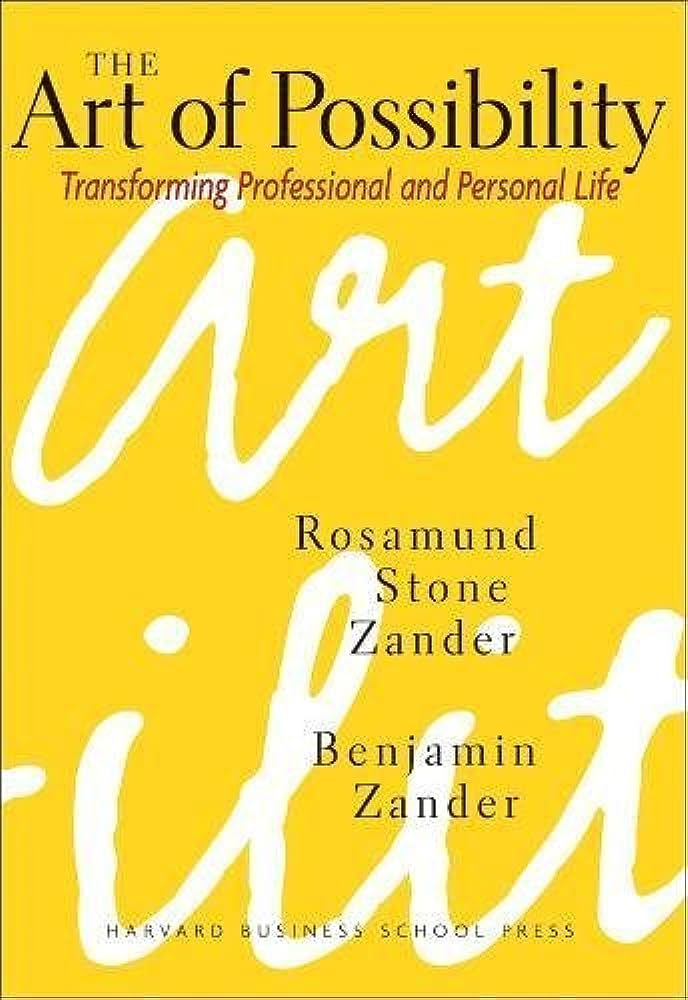
1 Line Summary
“The Art of Possibility: Transforming Professional and Personal Life” is a book written by Rosamund and Benjamin Zander, which provides practices for expanding one’s sense of what is possible in life, both professionally and personally.
What Will You Learn
Here are some of the benefits of reading “The Art of Possibility”. You’ll learn how to:
- see the world in a new way,
- create a more positive and hopeful outlook on life,
- set goals and achieve them,
- overcome challenges and obstacles,
- build relationships and work effectively with others,
- live a more fulfilling and meaningful life.
Best Quotations from the Book
- “The world is not a fixed place. It is constantly changing and we can shape that change.”
- “We are not victims of our circumstances. We create our own reality through our thoughts and beliefs.”
- “The first step to creating a better future is to believe that it is possible.”
- “We can’t change the past, but we can learn from it and create a better future.”
- “The only thing that stands between us and our dreams is the will to try, and the belief that we can achieve them.”
- “The possibility mindset is a choice. We can choose to see the world as a place of possibility or a place of limitation.”
Book Summary
The book is divided into three parts:
- Possibility Mindset: This part introduces the concept of the possibility mindset and explains how it can help us create a more positive and hopeful outlook on life.
- Art of Possibility: This part provides practical exercises and tools that we can use to develop the possibility mindset.
- Possibility Practice: This part shares stories and examples of people who have used the possibility mindset to create positive change in their lives.
The Possibility Mindset
The book provides actionable insights to transform challenges into opportunities and to foster creativity and growth. Here are the essentials of the Possibility Mindset elaborated in the book:
- Shift from Scarcity to Abundance: The Possibility Mindset challenges the scarcity mentality, urging readers to see the abundance of opportunities around them. By recognizing that possibilities are limitless, individuals can overcome self-imposed limitations and tap into their full potential. This shift in mindset enables a proactive approach to problem-solving and decision-making.
- Give Way to the Power of Choice: Embracing the Possibility Mindset involves recognizing one’s agency to make choices. The book encourages readers to make choices that align with their aspirations and values, thereby empowering them to shape their lives in meaningful ways. This emphasis on choice, cultivates a sense of ownership and responsibility for one’s actions.
- Practice Reframing and Transforming: The book underscores the importance of reframing challenges as opportunities for growth and transformation. By altering the perspective through which situations are viewed, individuals can find new ways to approach problems and innovate. This shift in perception allows for creative solutions and fosters resilience in the face of adversity.
- Cultivate an Attitude of Contribution: The Possibility Mindset promotes a focus on contributing to others and the broader community. By shifting attention away from self-centered concerns, individuals can develop a sense of inter-connectedness and empathy. This mindset shift encourages collaboration, fosters positive relationships, and enhances overall well-being.
- Practice “It’s All Invented”: The book introduces the concept that “much of the world is a product of human interpretation and invention”. This notion liberates individuals from fixed beliefs and societal norms, empowering them to challenge assumptions and redefine possibilities. By realizing that perceptions and realities can be reshaped, individuals can approach situations with curiosity and creativity.
The Art of Possibility
Here are some points outlining the practical exercises and tools elaborated in the book:
Practice the “Two Loops” Technique
- The book introduces the concept of “two loops” – a practice that involves differentiating between the current reality and the possibilities that exist beyond it.
- This technique encourages individuals to acknowledge their present circumstances while also envisioning a future filled with potential.
- By alternating between these two loops, individuals can maintain a balanced perspective that fosters both realism and optimism.
Embrace the “Rule of Thumb” of Radiating Possibility
- The authors suggest adopting a simple rule of thumb: “In any interaction, assume that people are contributing their best.“
- This mindset shift encourages individuals to give others the benefit of the doubt and approach interactions with openness and positivity.
- By assuming positive intentions, individuals can create a conducive environment for collaboration and mutual growth.
Practice “Giving an A”
- The “Giving an A” exercise encourages individuals to approach relationships and interactions as if they have already received an “A” – a symbol of mutual respect and high expectations.
- By treating others with unwavering trust and belief in their potential, individuals can elevate their interactions and inspire excellence.
- This exercise nurtures a culture of trust and encourages others to rise to their best selves.
Engage in “The Practice of Graciousness”
- The book introduces the concept of “graciousness” – the act of acknowledging others’ efforts and accomplishments genuinely.
- By celebrating the successes of those around them, individuals contribute to a positive and supportive environment.
- This practice creates a cycle of encouragement and motivates others to continue striving for excellence.
Utilize the “Framework for Possibility”
The authors offer a framework for reframing challenges and obstacles. This involves acknowledging the current reality, identifying self-imposed constraints, and envisioning alternate scenarios.
By systematically dissecting problems and exploring different perspectives, individuals can uncover innovative solutions and overcome barriers that may have seemed insurmountable.
The Possibility Practice
Embrace the Perspective of “What Might Be”
- The book encourages to adopt a mindset of possibility by focusing on “what might be” rather than being limited by “what is.”
- By consistently asking “What might I create or achieve?” individuals can channel their energy towards creative solutions and positive outcomes.
Reframe Challenges as Opportunities
- Possibility practice involves reframing obstacles and setbacks as opportunities for growth and learning.
- By adopting this mindset shift, individuals can transform adversity into a catalyst for positive change.
- The authors suggest exploring the question, “What new possibility does this situation open up?” This approach encourages a proactive stance towards challenges.
Practice the “It’s All Invented” Principle
- The book introduces the concept that much of what we perceive as reality is a product of human interpretation.
- By embracing the idea that “it’s all invented,” individuals can challenge conventional norms and redefine possibilities.
- This practice empowers individuals to question assumptions and consider alternative perspectives, fostering innovation and positive change.
Engage in Generative Conversations
- Possibility practice involves engaging in generative conversations that focus on growth and collaboration.
- These conversations are characterized by active listening, openness and a willingness to explore new ideas.
- By embracing a generative dialogue, individuals can uncover shared goals and create synergistic solutions that lead to positive change.
Apply the “Rule of Thumb” of Radiating Possibility
- The book introduces the “rule of thumb” that encourages individuals to assume positive intentions in their interactions.
- By radiating possibility through this mindset, individuals can create an atmosphere of trust and openness.
- This practice leads to improved relationships, increased collaboration and a conducive environment for positive change.
If you want to create a positive and hopeful outlook on your life, you need to read “The Art of Possibility”. This book will teach you how to see the world in a new way and to create the life you’ve always wanted.
For more insights, read “Creating Communications (Part-1)“, “Creating Communication (Part-2)”,“Exactly What to Say“, “How to Talk to Anyone“, “Just Listen“, “How to Win Friends and Influence People“, “Crucial Conversations” and “Relation between Self Awareness and Effective Communication“.


Pingback: “The Power of Now” by Eckhart Tolle -
Pingback: “The Slight Edge” by Jeff Olson -